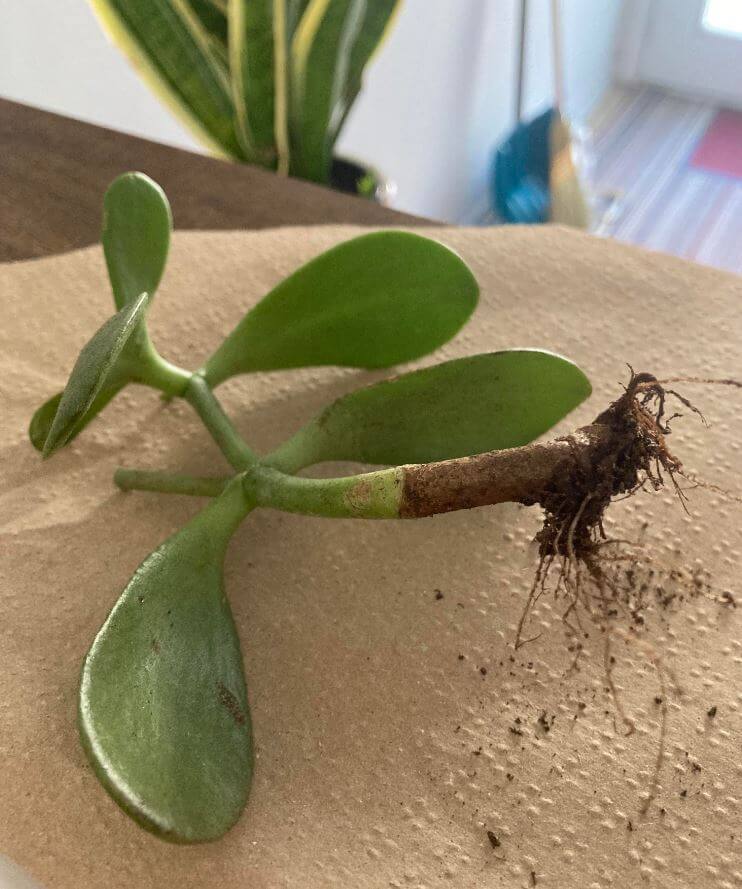Last Updated on April 8, 2023 by a Friendly Gardener
Botanically known as the Crassula ovata, Jade plants are favorites in both indoor and outdoor gardens. They are incredibly easy to take care of and are drought-tolerant. The Jade plant is a succulent native to South Africa that now boasts global popularity. One of the principal challenges of cultivating a Jade plant is the risk of root rot.
Root rot can be fatal. Symptoms include yellowing foliage, leaf drop, stunted growth, and wilting. However, with good prevention, you can protect your plant, and should your plant develop root rot, there are things you can do to save it.
Root Rot Jade Plant
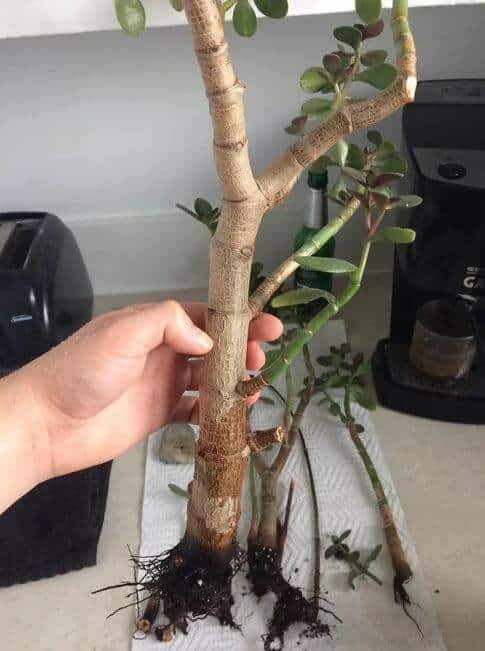
This disease will attack the root system of your jade plant. When left untreated, roots will begin to rot and eventually die. This condition is generally caused by excessive moisture content in the soil bed. When soil becomes soggy or water-logged, this is usually due to overwatering or poor drainage, although bacteria and fungi contained in the soil can also be a cause.
If you suspect your Jade plant is affected by root rot, you need to intervene immediately. The first thing to do is examine the roots. Remove the plant from its container and gently remove the soil around the roots. Examine the roots thoroughly for symptoms of decay. If roots appear mushy or blackened, these infected roots should be trimmed off and removed. Repot your Jade plant in a fresh growing medium formulated for succulents. Re-evaluate your watering schedule.
Jade Plant Root Rot Symptoms
The most common symptoms of root rot include the wilting of stems and foliage, yellowing leaves, and darkened roots. Your plant may also experience what appears to be sudden death. Roots are the best indicator of root rot. However, there are other signs to watch for:
• Black spots on foliage
These generally indicate root rot and that it is spreading quickly throughout your plant.
• Mushy, darkened root systems
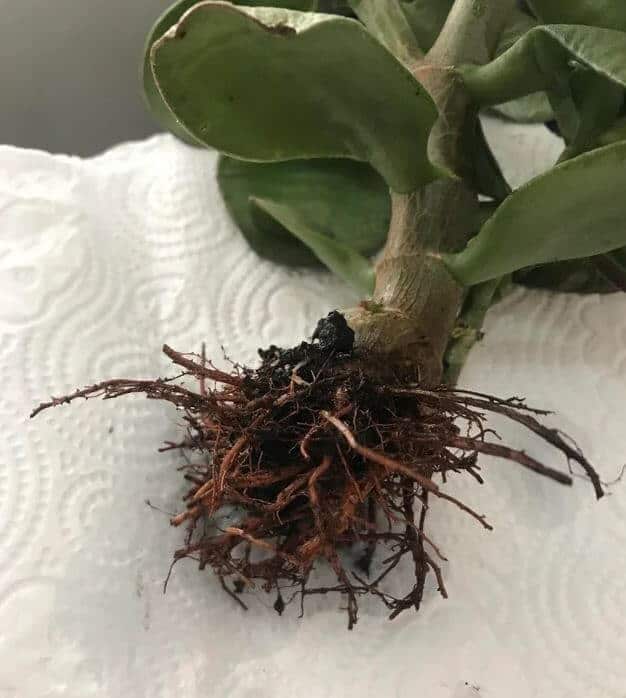
A foul odor emanating from the root system is a sign that the roots are compromised. They will generally appear to be dark brown or blackened and feature soft ends. Healthy roots should appear white and feel firm to the touch. If you pull on them gently, they will break easily.
• Wilting, limp Jade plant
Leaf drop or sparse foliage, stem wilting and dieback are also signs of root rot. Foliage may feel soft and even sticky, as leaves are unable to store all the water they are given. Stems will weaken and be unable to support the plant’s weight. When left without treatment, the plant will die.
• Pale or Yellowing Foliage
If leaves begin to fade in color or turn yellow, your plant has a problem. Overwatering is the principal cause of yellowing foliage. If foliage has an unhealthy appearance, there is a good chance that the plant has a systemic issue that includes the root system.
• Slow or Stunted Growth
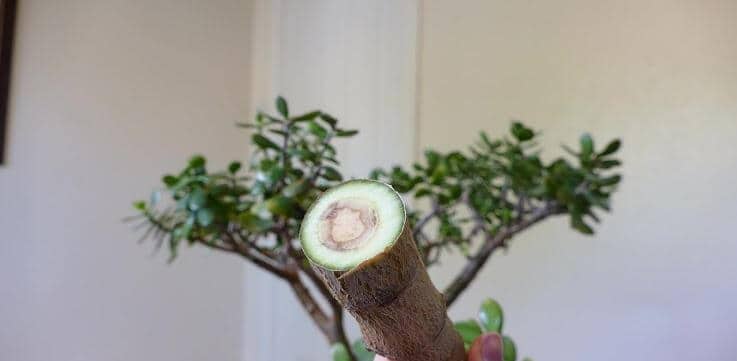
If your plant appears stunted or shows no sign of new growth, examine the root system and the soil bed for evidence of root rot. Perhaps the soil is not providing all the necessary nutrients for a healthy plant.
Causes of Jade Plant Root Rot and How to Fix Root Rot Jade Plant
There are several common causes of Jade plant health issues that can lead to root rot. These include:
• Overwatering
Excessive watering is most probably the number one cause of root rot in plants. If your plant has been left standing in soggy soil, it’s necessary to examine the root system. Remove your plant from its container and prune any infected mushy roots. Rinse the remaining healthy root system and replant your Jade plant in fresh soil. Water sparingly and only when the soil bed is dry.
• Lack of Drainage
Poor soil drainage is another cause. Perhaps you are not overwatering, but the soil bed is compacted, or the container does not ensure proper drainage. If foliage begins to yellow, root systems and soil should be examined for root rot and improper drainage. Improper drainage or a lack of drainage permit water to pool around root systems. This can suffocate roots or create an environment conducive to the development of fungal growth.
Jade plants will benefit from light, well-draining soil blends that are specifically formulated for succulents. Also, beware of the container size. If you select a pot that is too large, it will hold more soil than necessary, and this excess soil will absorb extra water.
• Environmental Temperature
Jade plants hail from South Africa, so they thrive in arid climates by storing water in their cushion-like leaves. They do not like the cold and can suffer from root rot when left in moist environments or colder temps for lengthy periods. Cold can cause leaves to drop or turn yellow. Stems may turn soft. This plant does best when cultivated in temperatures ranging between 65° and 75° F. When temps drop below 40°F, soil beds will require more time to dry out creating conditions for potentially developing root rot.
• Insufficient Light

The Crassula Ovata needs bright sunlight exposure to thrive. If they receive insufficient light, they will be more susceptible to health issues and disease. Root rot can be caused by bacteria or fungi, so inadequate light can weaken the plant to the point that these pathogens attack it. Inadequate light can also slow photosynthesis considerably, impeding adequate nourishment and weakening the plant. Keep your plant in a sunny location.
• Bacterial soft rot jade plant
This occurs when the plant is attacked by the Erwinia bacteria. This infection will spread through the entire plant causing it to wilt with the jade plant stem turning brown. The plant will soften, become mushy, and emit a foul odor. This infection can cause the plant to collapse. In the case of bacterial soft rot, the plant should be isolated. The soil should be disposed of and affected plant parts trimmed off and destroyed. Place your plant in fresh soil in a spot with good air circulation. Do not mist the plant and only water when the soil has completely dried out.
The Bottom Line
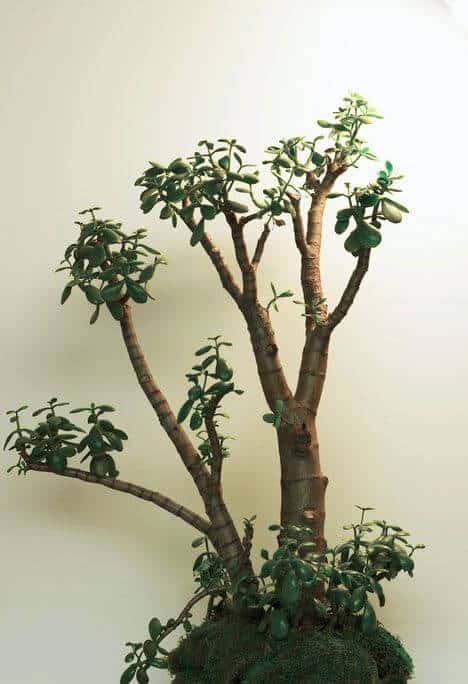
The most important thing you can do for your plant is to not overwater. Select a bright, sunny spot for your Jade Plant where the humidity is on the low side. Do not use outdoor garden soil but select a succulent potting mix. Opt for a correctly sized terracotta or clay pot as opposed to plastic to aid in wicking away excess moisture. When working with your plant always use sterile tools and if you are propagating, be sure to use healthy stem cuttings.

